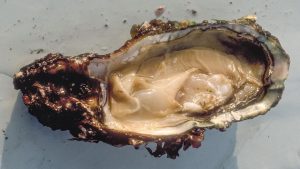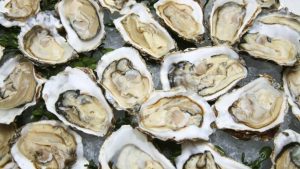Michael Casey of The Charlotte Observer reports that for the past 25 years, researcher Stephen Jones has tried to understand the threat that bacteria may pose to oysters in New Hampshire’s Great Bay estuary. He often couldn’t get funding to study the problem. But that is beginning to change as scientists notice “something is going on.”
![Oyster-Vancouver, B.C.- 07/05/07- Joe Fortes Oyster Specialist Oyster Bob Skinner samples a Fanny Bay oyster at the restuarant. Vancouver Coastal Health now requires restaurants to inform their patrons of the dangers of eating raw shellfish. (Richard Lam/Vancouver Sun) [PNG Merlin Archive]](https://barfblog.com/wp-content/uploads/2016/12/raw.oyster.jpg)
Scientists are recognizing that a waterborne disease sickening tens of thousands of people each year is associated with warmer waters of the Gulf of Mexico moving northward, partly due to climate change. The problem is extremely rare in New Hampshire and neighboring Maine, but scientists have seen cases elsewhere in New England and expect it to become a bigger problem.
Cases of human illness have been piling up since Sept. in Florida, Massachusetts and Western Canada.
“We have this situation in the northern part of the United States and other cooler climates where people haven’t thought this had been a problem,” said Jones, of the Northeast Center for Vibrio Disease and Ecology at the University of New Hampshire. “In the last 10 or 20 years, it’s become very apparent that there is something going on.”
In a paper in the science journal PLOS One, Jones and other scientists reported their findings that illnesses from vibrio bacteria have jumped significantly in New England — from five cases in 2000 to 147 in 2013. Disease-causing bacteria can contaminate oysters, leading to infections such as diarrhea, vomiting and abdominal pain.
Jones and his colleague, Cheryl Whistler, concluded that warmer waters in the Great Bay, higher salinity and the presence of chlorophyll all contributed to higher concentrations of one of the more common vibrio species that makes people sick — vibrio parahaemolyticus. The researchers are hoping their findings will serve as the foundation of an early warning system for the region’s booming oyster industry.
 Currently, all experts can do is monitor the waters and rapidly cool harvested oyster to halt bacteria growth.
Currently, all experts can do is monitor the waters and rapidly cool harvested oyster to halt bacteria growth.
An August report in the Proceedings of the National Academy of Sciences found that warming waters were linked to waterborne food poisoning, especially from eating raw oysters.
“There is similar reporting in Alaska where it has been found that increased cases have been occurring where it has not been reported before because of the temperature rise,” said the study’s lead author, Rita Colwell, of the University of Maryland.
The industry has welcomed Jones and Whistler’s work, noting that outbreaks like the one that occurred last month in Massachusetts need to be avoided. Nearly 75 people were sickened.
“When you are involved with a recall because people have gotten sick, you are a losing tremendous amount of money and a tremendous amount of credibility,” said Tom Howell, president of Spinney Creek Shellfish Inc., in Eliot, Maine, which harvests oysters from the Great Bay. A predictive model would allow the industry to move more aggressively to avoid an outbreak, he said.
But Howell and Chris Nash, New Hampshire’s shellfish program manager, said that day could be far off.
“We are still learning what seems to trigger these pathogenic strains to multiply … We don’t have that knowledge yet and it may be that we never do,” Nash said. “We are talking about biological organisms … They react to their environment different, the same way humans do.”
 Since mid-February 2021, 46 mandatory declarations (DO) of collective food poisoning (TIAC) suspected of being linked to the consumption of oysters have been sent to Public Health France and/or to the General Directorate of food .
Since mid-February 2021, 46 mandatory declarations (DO) of collective food poisoning (TIAC) suspected of being linked to the consumption of oysters have been sent to Public Health France and/or to the General Directorate of food . 





![Oyster-Vancouver, B.C.- 07/05/07- Joe Fortes Oyster Specialist Oyster Bob Skinner samples a Fanny Bay oyster at the restuarant. Vancouver Coastal Health now requires restaurants to inform their patrons of the dangers of eating raw shellfish. (Richard Lam/Vancouver Sun) [PNG Merlin Archive]](https://barfblog.com/wp-content/uploads/2016/12/raw.oyster.jpg)


